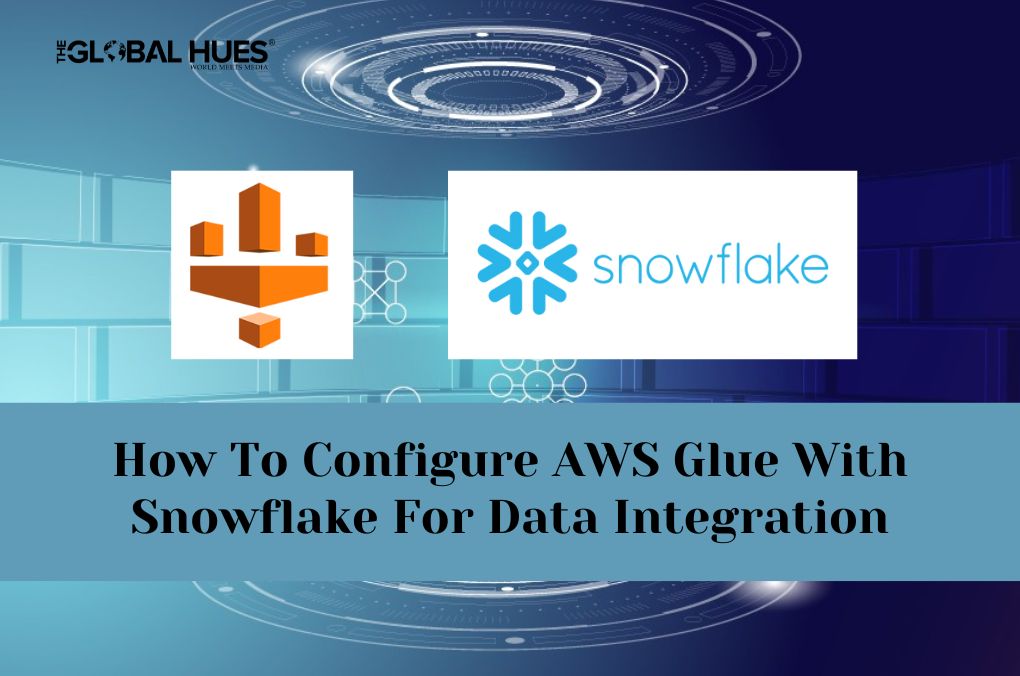The digital world is evolving every day. With the evolution of data and its processing methods, developers are constantly trying to build better tools to manage and analyze data. Enterprises are generating insurmountable data regularly; from multiple sources and in various formats that need coding and de-coding.
Table of contents:
- Introduction
- What is AWS Glue
- Features of AWS Glue
- What is AWS Glue Catalogue?
- What is Snowflake?
- What is data integration?
- Data integration approaches
- How to configure AWS Glue with a snowflake for data integration?
- How does configuration happen?
- Conclusion
Introduction:
It is becoming a challenge for businesses to meet their needs and manage their KPIs and performance. Developers and programmers understand the growing demand for powerful integration tools to manage businesses better. Hence, they are working hard to provide easy-to-use and affordable data integration software; for better data management and upscaling the businesses.
In a pool of insurmountable data, if you need a tool that does all the hard work of discovering, collecting, and managing your enterprise data, AWS Glue has a solution.
What is AWS Glue?
AWS Glue, powered by Amazon Web Service, is a serverless computing platform to help businesses manage their data. It provides faster, cheaper, and simpler data management services and easily integrates with multiple data sources. It connects with 70 diverse data sources and collects and manages data in a data catalog. Its key feature is it can analyze and categorize data and is a fully managed ETL (Extract, Transform, Load) service. However, to know better insights on CMO definitely AWS training plays an important role.
AWS Glue has also launched a new capability at AWS re: Invent 2020. It helps users arrange data integration workflow to support custom third-party connectors.
Features of AWS Glue
As a scalable data integration service, it discovers, analyzes, manages, and integrates data from multiple sources for application development, analytics, and machine learning.
1. DISCOVER
- The AWS data catalog discovers your data, no matter where its located, creates statistics and prepares queries for data management.
- You can also find a schema version history in your AWS catalog to understand how your data has changed.
- The AWS data catalog also contains tables; the metadata is stored in those tables and used in the authoring of ETL.
- A serverless feature of AWS Glue, AWS Glue Schema Registry controls validates the ongoing changes in the streaming data.
- AWS Glue is adaptable to the amount of workload you have and autoscale resources up and down based on your workload. Gone are the days of worrying about optimizing the number of workers or wasting money on idle resources.
2. PREPARE
- AWS Glue has a built-in machine-learning program that cleans your data and prepares it for analysis. It also has a feature called “Find matches” that deduplicates and finds matches that are imperfect matches of each other. You have to label the records as “matching” or non-matching,” and it will do the ETL job.
- It helps you edit, debug and test ETL code generated for you by providing developing endpoints.
- AWS Glue DataBrew normalizes data without the code for users like data analysts and data scientists. It provides a point-and-click visual interface to clean the data without writing any code.
- It also helps you define and detect the sensitive data in your data lake. It simplifies the identification process, and you can then report or replace the sensitive data on your catalog.
- Data engineers and data scientists who process large datasets in Python use AWS Glue for Ray. AWS Glue for Ray doesn’t need any infrastructure to manage because it is serverless.
- AWS Glue also creates custom visual transformations. These custom transformations reduce the dependence on Spark developers, and the ETL jobs become simpler to keep them up to date.
3. INTEGRATE
- AWS Glue makes the development of data integration jobs simple. Data engineers explore, experiment, process, and prepare data interactively on AWS Glue.
- AWS Glue provides built-in job notebooks with minimal set-up in AWS Glue studio.
- You can start multiple jobs with simple job scheduling. AWS Glue handles all inter-job dependencies, filter data, and retries if they fail.
- AWS Glue Flex is a flexible execution job class; It reduces non-urgent data integration workloads like data loads, testing, pre-production jobs, etc.
- The data lake in the AWS Glue reads, inserts, updates, and deletes files in your data catalog.
- It monitors, measures, and manages data quality in your data lakes and pipelines.
4. TRANSFORM
- AWS Glue generates the code to extract, transform, and load your data automatically; you define your ETL process, and it visually transforms with a drag-and-drop interface.
What is AWS Glue Catalogue?
AWS Glue Catalogue stores all the structural and operational metadata.
The references of data used as sources and targets of your ETL (Extract, Transform, and Load) jobs also contains in the AWS Glue Catalogue. You must first catalog your data to create a data lake or warehouse.
For every data set, you can create and store its physical location, add business-relevant attributes and table definitions, and track the data for how it has changed over time.
The AWS Glue has another feature of providing data integration with Amazon Athena, Amazon Redshift Spectrum, and Amazon EMR.
Along with CloudTrail and Lake Formation, the Data Catalogue gives you access to governance with schema change tracking and extensive audit with data access controls.
It means you’ll ensure that your data is not accidentally shared or modified inappropriately.
What is Snowflake?
Snowflake is a data platform company. It manages and stores big data for modern enterprises. Snowflake is a cloud-based data warehouse that operates on AWS – Amazon Web Services or Microsoft Azure.
As a fully managed SaaS (software as a service), it provides a single platform for data science, data engineering, data storage, warehousing, data lakes, application development, and consumption/sharing of real-time data.
Let’s quickly dive into its benefits for your business
- Its brilliant storage capacity: It automatically optimizes structured or semi-structured data for analysis and how to store the data.
- Powerful performance and speed: The cloud’s elasticity allows it to scale up and down based on the volume of data generated. The virtual warehouse can scale up and run faster and solve queries quickly if there is a need and scale down when the data is limited.
- Accessibility- Snowflake is unique: Queries from one virtual warehouse don’t affect another. Data scientists/analysts can scale it according to their needs without waiting for the process to complete.
- Easy Data Sharing: Snowflake allows users to share data and information with other users and non-Snowflake customers.
- Availability and Security: Snowflake is SOC 2 Type II certified, and other levels of security and encryption across the communication networks. It is also available to all platforms like AWS or Azure.
Now, we know enough about the two programs. It’s time to discuss Data Integration.
What is Data Integration?
In the pool of mishandled data, it is a challenge for businesses to bring all that together and present it to their target audience in a cohesive format.
Data Integration is a process where an enterprise uses software and other programming services to bring data from multiple sources/ platforms into one place and manage it all in a unified view for the users.
The primary purpose of data integration is to simplify data and make it effortless and freely available to consumers.
It is the need of the hour for enterprises to invest in data integration platforms, especially for small and mid-size businesses, because their data is not in one place. But once the enterprise starts to scale up, the need to manage becomes a priority; because proper data integration is necessary for continued growth.
Data Integration uses two approaches:
- ELT (Extract, Load, and Transform) – In this approach, the data is extracted from different sources, loaded in a data warehouse, and then transformed into a readable and usable format for the users to consume.
- ETL (Extract, Transform, and Load) – This approach uses the system to extract the information first multiple sources, transform it into an easy-to-read and visually appealing format, and then load the data into a data warehouse. The users can ask for a query and report the unified data in this approach.
It is a fact that both AWS Glue and Snowflake are working to help enterprises, big or small.
They are managing their data better and providing a virtual warehouse where their data is processed and shared in a simple format, along with a security facility. So, for better data management, AWS Glue and Snowflake can be combined. The Process of Configuring AWS Glue with Snowflake for the Integration of Data
How to configure AWS Glue with Snowflake for Data Integration?
Snowflake and AWS Glue, when coming together, enable the users to have complete control over their data by providing a fully supervised space that promotes easy integration with Snowflake’s data warehouse service. The union further promotes easy data sharing with consumers and flexibility in transforming the ETL/ELT pipelines.
How does the configuration process happen:
Some preconditions:
- The latest Snowflake Spark Connector
- The latest Snowflake JDBC Driver
- S3 bucket in the same region as AWS Glue
- AWS Glue 3.0 requires spark 3.1.1. – Snowflake Spark Connector 2.10.0 – spark_3.1 or higher, and Snowflake JDBC Driver 3.13.14 can be used.
The Set-up:
Step 1. Log in to AWS.
Step 2. Search for the S3 link and click on the S3 link.
- Create an S3 bucket and folder.
- Add the Spark Connector and JDBC .jar files to the folder.
- Create another folder in the same bucket to be used as the Glue temporary directory in later steps (see below).
Step 3. Switch to the AWS Glue Service.
Step 4. Click on Jobs on the left panel under ETL.
Step 5. Add a job by selecting the Spark script editor option, click Create, and then click on the Job Details tab.
- Provide a name for the job.
- Select an IAM role. Create a new IAM role if it doesn’t already exist, and be sure to add all Glue policies to this role.
- Select type Spark.
- Select the Glue version (see the note above for AWS Glue version 3.0)\
- Select Python 3 as the language.
- Click on Advanced properties to expand that section.
- Give the script a name.
- Set the temporary directory to the one you created in step 2c.
- Under Libraries in the path of the Dependent jar, add entries for both .jar files from 2b.
- Under Job parameters, enter the following information with your Snowflake account information. Include two dashes before each key.
- Click Save on the top right.
- Click on the top Script tab to enter a script.
Final Word
AWS Glue and Snowflake are making the data integration process easier for enterprises. Although, AWS Glue has the potential to manage the data overflow alone. But by its configuration with Snowflake and the Spark Connector’s query pushdown, the process is better optimized, and the ELT pipeline has become easy and flexible.
Above all, enterprises can present their users with easy-to-read and simplified data to consume across all communication platforms.
Author Bio:

I am Korra Shailaja, Working as a Digital Marketing professional & Content writer in MindMajix Online Training. I Have good experience in handling technical content writing and aspire to learn new things to grow professionally. I am an expert in delivering content on the market demanding technologies like Mulesoft Training, Dell Boomi Tutorial, Elasticsearch Course, Fortinet Course, PostgreSQL Training, Splunk, Success Factor, Denodo, etc.




